The WSTF-ISWI chromatin remodeling complex transiently associates with the human inactive X chromosome during late S-phase prior to BRCA1 and γ-H2AX
- PMID: 23166813
- PMCID: PMC3498190
- DOI: 10.1371/journal.pone.0050023
The WSTF-ISWI chromatin remodeling complex transiently associates with the human inactive X chromosome during late S-phase prior to BRCA1 and γ-H2AX
Abstract
Replicating the genome prior to each somatic cell division not only requires precise duplication of the genetic information, but also accurately reestablishing the epigenetic signatures that instruct how the genetic material is to be interpreted in the daughter cells. The mammalian inactive X chromosome (Xi), which is faithfully inherited in a silent state in each daughter cell, provides an excellent model of epigenetic regulation. While much is known about the early stages of X chromosome inactivation, much less is understood with regards to retaining the Xi chromatin through somatic cell division. Here we report that the WSTF-ISWI chromatin remodeling complex (WICH) associates with the Xi during late S-phase as the Xi DNA is replicated. Elevated levels of WICH at the Xi is restricted to late S-phase and appears before BRCA1 and γ-H2A.X. The sequential appearance of WICH and BRCA1/γ-H2A.X implicate each as performing important but distinct roles in the maturation and maintenance of heterochromatin at the Xi.
Conflict of interest statement
Figures
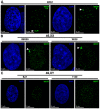


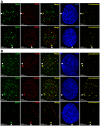
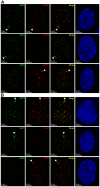
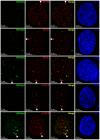
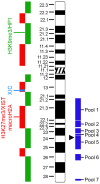
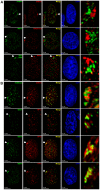


Similar articles
-
BRCA1 associates with the inactive X chromosome in late S-phase, coupled with transient H2AX phosphorylation.Chromosoma. 2005 Dec;114(6):432-9. doi: 10.1007/s00412-005-0029-1. Epub 2005 Nov 15. Chromosoma. 2005. PMID: 16240122
-
Random replication of the inactive X chromosome.Genome Res. 2014 Jan;24(1):64-9. doi: 10.1101/gr.161828.113. Epub 2013 Sep 24. Genome Res. 2014. PMID: 24065775 Free PMC article.
-
Histone acetylation controls the inactive X chromosome replication dynamics.Nat Commun. 2011;2:222. doi: 10.1038/ncomms1218. Nat Commun. 2011. PMID: 21364561 Free PMC article.
-
Chromatin remodeling by WSTF-ISWI at the replication site: opening a window of opportunity for epigenetic inheritance?Cell Cycle. 2005 Apr;4(4):543-6. doi: 10.4161/cc.4.4.1624. Epub 2005 Apr 22. Cell Cycle. 2005. PMID: 15753658 Review.
-
The roles of chromatin remodelling factors in replication.Results Probl Cell Differ. 2006;41:91-107. doi: 10.1007/400_007. Results Probl Cell Differ. 2006. PMID: 16909892 Review.
Cited by
-
Cell models to study regulation of cell transformation in pathologies of retinal pigment epithelium.J Ophthalmol. 2014;2014:801787. doi: 10.1155/2014/801787. Epub 2014 Aug 7. J Ophthalmol. 2014. PMID: 25177495 Free PMC article. Review.
-
Multiple facets of histone variant H2AX: a DNA double-strand-break marker with several biological functions.Nucleic Acids Res. 2015 Mar 11;43(5):2489-98. doi: 10.1093/nar/gkv061. Epub 2015 Feb 20. Nucleic Acids Res. 2015. PMID: 25712102 Free PMC article. Review.
-
Looking into the Eyes-In Vitro Models for Ocular Research.Int J Mol Sci. 2022 Aug 15;23(16):9158. doi: 10.3390/ijms23169158. Int J Mol Sci. 2022. PMID: 36012421 Free PMC article. Review.
-
Loss of WSTF results in spontaneous fluctuations of heterochromatin formation and resolution, combined with substantial changes to gene expression.BMC Genomics. 2013 Oct 29;14:740. doi: 10.1186/1471-2164-14-740. BMC Genomics. 2013. PMID: 24168170 Free PMC article.
-
Quantitative dose-response curves from subcellular lipid multilayer microarrays.Lab Chip. 2015 Aug 21;15(16):3397-404. doi: 10.1039/c5lc00478k. Lab Chip. 2015. PMID: 26167949 Free PMC article.
References
-
- Alabert C, Groth A (2012) Chromatin replication and epigenome maintenance. Nat Rev Mol Cell Biol 13: 153–167. - PubMed
-
- Portela A, Esteller M (2010) Epigenetic modifications and human disease. Nat Biotechnol 28: 1057–1068. - PubMed
-
- Lyon MF (1961) Gene action in the X-chromosome of the mouse (Mus musculus L.). Nature 190: 372–373. - PubMed
-
- Carrel L, Willard HF (2005) X-inactivation profile reveals extensive variability in X-linked gene expression in females. Nature 434: 400–404. - PubMed
Publication types
MeSH terms
Substances
Grants and funding
LinkOut - more resources
Full Text Sources
Miscellaneous

